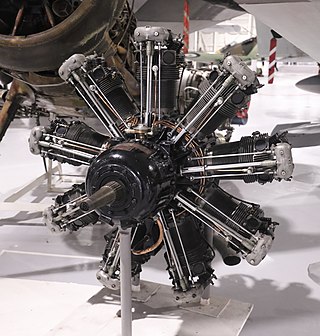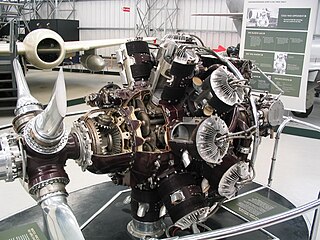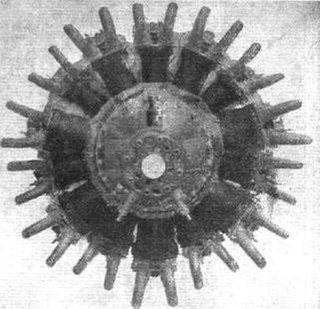
The Bristol Jupiter is a British nine-cylinder single-row piston radial engine that was built by the Bristol Aeroplane Company. Originally designed late in World War I and known as the Cosmos Jupiter, a lengthy series of upgrades and developments turned it into one of the finest engines of its era.

The Bristol Mercury is a British nine-cylinder, air-cooled, single-row, piston radial engine. Designed by Roy Fedden of the Bristol Aeroplane Company it was used to power both civil and military aircraft of the 1930s and 1940s. Developed from the earlier Jupiter engine, later variants could produce 800 horsepower (600 kW) from its capacity of 1,500 cubic inches by use of a geared supercharger.

The Bristol Hercules is a 14-cylinder two-row radial aircraft engine designed by Sir Roy Fedden and produced by the Bristol Engine Company starting in 1939. It was the most numerous of their single sleeve valve designs, powering many aircraft in the mid-World War II timeframe.

The Centaurus was the final development of the Bristol Engine Company's series of sleeve valve radial aircraft engines. The Centaurus is an 18-cylinder, two-row design that eventually delivered over 3,000 hp (2,200 kW). The engine was introduced into service late in the Second World War and was one of the most powerful aircraft piston engines to see service.

The Junkers Jumo 004 was the world's first production turbojet engine in operational use, and the first successful axial compressor turbojet engine. Some 8,000 units were manufactured by Junkers in Germany late in World War II, powering the Messerschmitt Me 262 fighter and the Arado Ar 234 reconnaissance/bomber, along with prototypes, including the Horten Ho 229. Variants and copies of the engine were produced in Eastern Europe and the USSR for several years following the end of WWII.

The BMW 003 is an early axial turbojet engine produced by BMW AG in Germany during World War II. The 003 and the Junkers Jumo 004 were the only German turbojet engines to reach production during World War II.

Tockington is a village in South Gloucestershire, England. Historically the village developed around farming based mainly on the rearing of cattle on the fertile flood plains. In more recent times Tockington has become an attractive location for commuters, being situated within the Green Belt and well connected with Bristol. It is south of Olveston and is located in a steep valley. The village also has the Swan Inn, a popular pub. The centre of the village, where the pub is located is a triangular junction.
The BMW 802 was a large air-cooled radial aircraft engine, built using two rows of nine cylinders to produce what was essentially an 18-cylinder version of the 14-cylinder BMW 801. Although promising at first, development dragged on and the project was eventually cancelled to concentrate on jet engines instead.
Sir Alfred Hubert Roy Fedden MBE, FRAeS was an engineer who designed most of Bristol Engine Company's successful piston aircraft engine designs.
Cosmos Engineering was a company that manufactured aero-engines in a factory in Fishponds, Bristol during World War I. Sir Roy Fedden, the company's principal designer, developed the 14-cylinder radial Mercury engine during this period. The company was taken over by the Bristol Aeroplane Company in 1920.
Bill Gunston was a British aviation and military author. He flew with Britain's Royal Air Force from 1945 to 1948, and after pilot training became a flying instructor. He spent most of his adult life doing research and writing on aircraft and aviation. He was the author of over 350 books and articles. His work included many books published by Salamander Books.
The Bristol Type 32 Bullet was a British biplane racing aircraft. It was designed in 1919 by Frank Barnwell as a high-speed testbed for the Jupiter engine being developed in Bristol by Roy Fedden for the Cosmos Engineering company, and also to publicise the company's name by participating in air races.

The Cosmos Mercury was a fourteen-cylinder twin-row air-cooled radial aeroengine. Designed by Roy Fedden of Cosmos Engineering, it was built in the United Kingdom in 1917. It produced 347 horsepower (259 kW). It did not enter production; a large order was cancelled due to the Armistice.

The Bristol Scout E and F were a British single-seat biplane fighters built in 1916 to use newer and more powerful engines. It was initially powered by the Sunbeam Arab, but the third prototype was used as a testbed for the Cosmos Mercury, marking the start of Roy Fedden's association with the Bristol Aeroplane Company. The Armistice ended hopes of production.

Völkenrode is a quarter (Stadtteil) of Braunschweig, Lower Saxony, Germany. Formerly a municipality in its own right and part of the district of Braunschweig, it was incorporated into the city of Braunschweig in 1974. Today, it is part of the Stadtbezirk Lehndorf-Watenbüttel.
The Deutsche Luftfahrtforschungsanstalt was a secret German facility for airframe, aeroengine, and aircraft weapons testing during the Second World War. It was Germany's "most advanced and extensive [aviation] research establishment, outside of the existing Erprobungsstelle network of military aviation evaluation facilities, themselves headquartered at Rechlin.
Messerschmitt P.1108 Fernbomber was a design for a jet-propelled bomber developed for the Luftwaffe by Messerschmitt during the last years of Nazi Germany. It was never completed.
The Fedden car was a British automobile produced after the Second World War by Roy Fedden Ltd. It was never manufactured.
The Fedden Mission was a British scientific mission sent by the Ministry of Aircraft Production to Germany at the end of the Second World War in Europe, to gather technical intelligence about German aircraft and aeroengines. It was named for the Mission's leader, Roy Fedden. It visited Bad Oeynhausen, Bad Eilsen, Völkenrode, Braunschweig, Magdeburg, Oschersleben, Staßfurt, Dessau, Kothen, Nordhausen, Göttingen, Kassel, Eisenach, Frankfurt, Rüsselsheim, Darmstadt, Stuttgart, Esslingen, Reutlingen, Mengen, Lindau, Freising, Munich, Rosenheim, Kochel, Oberammergau, Kolbermoor, Salzburg, Spittal, Villach, and Klagenfurt. This is much less than the fifty-two locations they had intended to visit when the Mission began.
The Bristol Phoebus was an early turbojet engine developed by Bristol Engines. It was based on the gas generator core of the Bristol Proteus. The Phoebus was used for development but only a handful were made. As with other Bristol engines, it took its name from classical mythology.